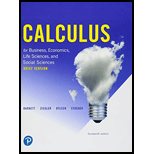
Concept explainers
Matched Problem 2 In 1950, coal was still a major source of fuel for home energy consumption, and the percentage of occupied housing units heated by fuel oil was only 22.1%. Add the data for 1950 to the data for Example 2, and compute the new least squares line and the new estimate for the percentage of occupied housing units heated by fuel oil in the year 1995. Discuss the discrepancy between the two estimates. (As in Example 2. let .x = 0 represent 1960.)
Example 2 Energy Consumption The use of fuel oil for home healing in the United States has declined steadily for several decades. Table 7 lists the percentage of occupied housing units in the United States that were heated by fuel oil for various years between 1960 and 2015. Use the data in the table and linear regression to estimate the percentage of occupied housing units in the United States that were heated by fuel oil in the year 1995.
Table 7 Occupied Housing Units Heated by Fuel Oil
| Year | Percent | Year | Percent |
| 1960 | 32.4 | 1999 | 9.8 |
| 1070 | 26.0 | 2009 | 7.3 |
| 1979 | 19.5 | 2015 | 5.1 |
| 1989 | 13.3 |
Source: U.S. Census Bureau
Want to see the full answer?
Check out a sample textbook solution
Chapter 7 Solutions
Pearson eText for Calculus for Business, Economics, Life Sciences, and Social Sciences, Brief Version -- Instant Access (Pearson+)
- Find all values of x for the given function where the tangent line is horizontal. 3 =√x³-12x² + 45x+5arrow_forwardFind the equation of the tangent line to the graph of the given function at the given value of x. 6 f(x) = x(x² - 4x+5)*; x=2arrow_forward7. Suppose that X is a set, that I is a nonempty set, and that for each i Є I that Yi is a set. Suppose that I is a nonempty set. Prove the following:2 (a) If Y; CX for all i EI, then Uiel Yi C X. ¹See Table 4.8.1 in zyBooks. Recall: Nie X₁ = Vi Є I (x = X₁) and x = Uier X₁ = i Є I (x Є Xi). (b) If XCY; for all i Є I, then X Ciel Yi. (c) U(x)=xnUY. iЄI ΕΙarrow_forward
 Linear Algebra: A Modern IntroductionAlgebraISBN:9781285463247Author:David PoolePublisher:Cengage Learning
Linear Algebra: A Modern IntroductionAlgebraISBN:9781285463247Author:David PoolePublisher:Cengage Learning Functions and Change: A Modeling Approach to Coll...AlgebraISBN:9781337111348Author:Bruce Crauder, Benny Evans, Alan NoellPublisher:Cengage LearningAlgebra & Trigonometry with Analytic GeometryAlgebraISBN:9781133382119Author:SwokowskiPublisher:Cengage
Functions and Change: A Modeling Approach to Coll...AlgebraISBN:9781337111348Author:Bruce Crauder, Benny Evans, Alan NoellPublisher:Cengage LearningAlgebra & Trigonometry with Analytic GeometryAlgebraISBN:9781133382119Author:SwokowskiPublisher:Cengage
 College AlgebraAlgebraISBN:9781305115545Author:James Stewart, Lothar Redlin, Saleem WatsonPublisher:Cengage Learning
College AlgebraAlgebraISBN:9781305115545Author:James Stewart, Lothar Redlin, Saleem WatsonPublisher:Cengage Learning Algebra and Trigonometry (MindTap Course List)AlgebraISBN:9781305071742Author:James Stewart, Lothar Redlin, Saleem WatsonPublisher:Cengage Learning
Algebra and Trigonometry (MindTap Course List)AlgebraISBN:9781305071742Author:James Stewart, Lothar Redlin, Saleem WatsonPublisher:Cengage Learning





